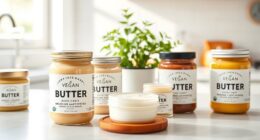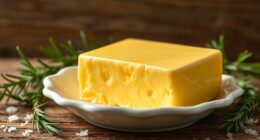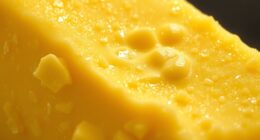As I delved into the world of butter production, I was astounded by the hidden environmental impacts that accompany this seemingly innocent staple. From the lush pastures to the creamy final product, every step of the process has its consequences.
Land clearing, water pollution, greenhouse gas emissions, and biodiversity loss are just a few of the alarming issues at hand.
In this article, we will explore the shocking realities and seek out sustainable alternatives to mitigate the damage caused by butter production.
Key Takeaways
- Churning cream to produce butter has significant impacts on soil quality and air pollution.
- Excessive butter consumption leads to increased land use for cultivating animal feed crops, contributing to deforestation and land degradation.
- Butter production requires significant amounts of water for irrigation, processing, and cleaning, straining water resources and causing pollution.
- Butter production contributes to methane emissions, a potent greenhouse gas, through the digestive processes of dairy cows and energy-intensive processes.
The Butter Production Process
The butter production process involves churning cream until it reaches a solid state. This process has significant impacts on soil quality and air pollution.
When it comes to soil quality, butter production can have both positive and negative effects. On one hand, dairy farms can contribute to soil fertility through the application of manure and other organic fertilizers. These additions can improve soil structure and enhance nutrient availability. On the other hand, intensive dairy farming practices can lead to soil erosion and nutrient loss, especially when combined with overgrazing and improper land management. This can result in decreased soil quality and increased sediment runoff into nearby water bodies.
In terms of air pollution, butter production can also have detrimental effects. The production of butter involves the use of machinery and equipment, which can emit greenhouse gases and other pollutants into the atmosphere. Additionally, dairy cows produce methane, a potent greenhouse gas, through their digestive processes. This methane contributes to climate change and air pollution. Furthermore, the transportation of raw materials and finished products in the butter production process also contributes to air pollution through vehicle emissions.
Overall, while butter production can have some positive impacts on soil quality through the use of organic fertilizers, it also has negative effects on soil erosion and nutrient loss. Additionally, the production process contributes to air pollution through the emission of greenhouse gases and pollutants. It is important for the dairy industry to adopt sustainable practices and technologies to mitigate these environmental impacts.
Land Use and Deforestation
Avoiding the use of ‘The’, you should know that excessive butter consumption leads to increased land use and deforestation.
Butter production requires vast amounts of land to cultivate crops for animal feed, contributing to land degradation and soil erosion. The demand for butter has risen significantly in recent years, resulting in the expansion of agricultural land to meet this demand. This expansion often leads to the clearing of forests, which not only disrupts ecosystems but also releases large amounts of carbon dioxide into the atmosphere, contributing to climate change.
Land degradation occurs when the quality and productivity of soil decline due to unsustainable land management practices. The intensive farming methods used to produce the crops for butter production, such as excessive tilling and the use of chemical fertilizers, contribute to soil erosion. This erosion not only affects the fertility of the land but also leads to the loss of topsoil, which is essential for plant growth.
Furthermore, deforestation, a direct consequence of increased butter consumption, exacerbates the negative environmental impacts. Forests play a crucial role in maintaining biodiversity, regulating the water cycle, and storing carbon dioxide. When forests are cleared, the unique ecosystems they support are destroyed, and the carbon stored in trees is released back into the atmosphere, further contributing to climate change.
Water Usage and Pollution
Excessive butter consumption contributes to increased water usage and pollution. The production of butter relies heavily on water, from the irrigation required to grow animal feed crops to the processing and cleaning involved in the manufacturing process. This excessive water usage puts a strain on our water resources, especially in regions where water scarcity is already a concern. Additionally, the production of butter also contributes to water pollution through agricultural runoff. When farmers use fertilizers and pesticides on their animal feed crops, these chemicals can leach into nearby water bodies, contaminating them and harming aquatic ecosystems.
To paint a clearer picture, here are three key points to consider:
- Butter production requires significant amounts of water for irrigation, processing, and cleaning.
- Water scarcity in certain regions is exacerbated by the excessive water usage in butter production.
- The use of fertilizers and pesticides in animal feed crops can result in water pollution through agricultural runoff.
To mitigate these environmental impacts, water conservation practices should be implemented throughout the butter production process. This can include utilizing efficient irrigation techniques, implementing water recycling systems in processing plants, and promoting sustainable farming practices that minimize the use of chemical inputs. By prioritizing water conservation and reducing agricultural runoff, we can minimize the environmental footprint of butter production and protect our precious water resources.
Greenhouse Gas Emissions
When it comes to butter production, one key point to consider is its contribution to methane emissions.
Methane is a potent greenhouse gas that significantly contributes to climate change.
As consumers, it is important to explore sustainable alternatives for butter that can help reduce these emissions and mitigate their environmental impact.
Butter and Methane Emissions
Butter production contributes to methane emissions, which are a significant driver of climate change. Methane is a potent greenhouse gas that has a much higher warming potential than carbon dioxide. Here are some key points to consider regarding the relationship between butter production and methane emissions:
- Cows, the primary source of milk for butter production, produce methane during the digestion process.
- The conversion of milk to butter involves energy-intensive processes, which contribute to its carbon footprint.
- The demand for butter has been increasing globally, leading to a higher production volume and subsequently more methane emissions.
These findings highlight the need to address the environmental impact of butter production and explore sustainable alternatives. Transitioning to sustainable alternatives can help mitigate the methane emissions associated with butter production and contribute to a greener future.
Sustainable Alternatives for Butter
If you’re looking for a sustainable alternative to butter, there are several options available that can help reduce your carbon footprint.
Plant-based spreads and animal-free butter alternatives are becoming increasingly popular as people become more conscious of the environmental impact of butter production. These alternatives are made from various plant-based ingredients such as nuts, seeds, and oils.
Not only do they provide a similar taste and texture to traditional butter, but they also offer health benefits such as being lower in saturated fat and cholesterol.
Additionally, plant-based spreads and animal-free butter alternatives require fewer resources to produce, emit fewer greenhouse gases, and have a lower overall environmental impact compared to butter made from animal products.
Making the switch to these alternatives can be a simple yet impactful step towards a more sustainable lifestyle.
Waste Management and Disposal
Butter waste management is an important aspect of sustainable butter production. In order to minimize the environmental impact, it’s crucial to implement effective and sustainable disposal methods for butter waste.
This discussion will explore various strategies and techniques for managing butter waste in a way that promotes sustainability and reduces harm to the environment.
Butter Waste Management
You should consider recycling and composting to properly manage the waste generated by butter production. Recycling and composting offer effective solutions for butter waste reduction and recycling. Here are some benefits of these methods:
-
Recycling: Recycling butter waste can help reduce the amount of waste sent to landfills. This waste can be processed and reused to create new products or materials.
-
Composting: Composting butter waste allows it to decompose naturally and become nutrient-rich soil. This can be used to fertilize gardens and farms, promoting sustainable agriculture.
By implementing these practices, we can minimize the environmental impact of butter production and contribute to a more sustainable future.
Now, let’s explore other sustainable disposal methods to further address the waste generated by butter production.
Sustainable Disposal Methods
To minimize waste and promote sustainability, I believe it is crucial to explore other sustainable disposal methods for butter production.
Fortunately, there are several sustainable recycling methods and composting solutions available that can help address this issue.
One option is to implement a recycling program specifically designed for butter production waste. This would involve collecting and recycling packaging materials such as cardboard boxes and plastic containers.
Additionally, organic waste from butter production, such as milk solids or excess butter, can be composted instead of being disposed of in landfills. Composting not only reduces waste but also creates nutrient-rich soil that can be used in agriculture.
Biodiversity Loss and Habitat Destruction
If you’re not careful, the demand for butter could contribute to the loss of biodiversity and destruction of habitats. Butter production has a significant carbon footprint, resulting from the intensive farming practices required to produce the large quantities of milk needed for butter production. This carbon footprint is a contributing factor to climate change, which in turn affects biodiversity and habitats.
Here are three key ways in which butter production impacts biodiversity and habitats:
-
Deforestation: The expansion of dairy farms to meet the demand for milk leads to deforestation, as forests are cleared to make space for grazing lands and feed crops. This destruction of natural habitats threatens the survival of countless plant and animal species.
-
Pesticide use: Butter production often involves the use of pesticides on feed crops, which can have detrimental effects on pollinators such as bees and butterflies. These essential pollinators play a crucial role in biodiversity by ensuring the reproduction of plants and the maintenance of ecosystems.
-
Water pollution: The runoff from dairy farms, including waste and chemicals, can contaminate water bodies, leading to the destruction of aquatic habitats and negatively impacting aquatic species.
It is important to consider the environmental consequences of butter production and to seek sustainable alternatives that minimize the impact on biodiversity and habitats.
Sustainable Butter Production Alternatives
Sustainable alternatives for butter production can help mitigate the negative effects on biodiversity and habitats. As a consumer, I’m always on the lookout for products that are produced using sustainable farming practices and that have less impact on the environment.
Thankfully, there are several alternative dairy products available today that can serve as substitutes for butter.
One such alternative is plant-based butter, which is made from oils derived from plants like coconut, avocado, or olive. These plant-based butters are cholesterol-free and have a lower carbon footprint compared to traditional butter. Additionally, they’re produced without the need for animal agriculture, reducing the strain on natural resources and habitats.
Another sustainable option is cultured butter, which is made from fermented cream. This traditional method of butter production not only adds a unique flavor but also helps in reducing waste by utilizing the byproducts of dairy production. Cultured butter is often made using organic and grass-fed milk, ensuring a more sustainable and environmentally friendly option.
Furthermore, there are alternative dairy spreads available that are made from nuts, such as almond or cashew butter. These spreads offer a creamy texture and flavor similar to butter while being a healthier and more sustainable choice.
By opting for these sustainable alternatives, we can support the reduction of biodiversity loss and habitat destruction associated with traditional butter production.
It’s essential to make informed choices as consumers and actively seek out products that align with our values of sustainability and environmental preservation.
Frequently Asked Questions
How Does Butter Production Impact Human Health and Nutrition?
Butter consumption can have an impact on human health and nutrition. There are potential health risks associated with consuming too much butter, such as increased risk of heart disease due to its high saturated fat content.
However, it’s important to note that moderation is key. Butter can be a source of essential nutrients like vitamins A and E.
It’s important to balance butter consumption with a varied and balanced diet to maintain good health.
What Are the Economic Implications of Butter Production on Local Communities and Global Markets?
The economic implications of butter production on local communities and global markets are significant.
Butter production can contribute to the economic viability of local communities by creating jobs and generating income.
However, market fluctuations can also impact the profitability of butter production, affecting both producers and consumers.
It is important to analyze market trends and adapt strategies to ensure sustainability in the face of economic challenges.
Overall, the economic aspect of butter production plays a crucial role in the industry’s success and its impact on communities and markets.
Are There Any Social and Cultural Aspects Associated With Butter Production?
There are social implications and cultural practices associated with butter production.
Butter is often seen as a staple in many cultures, and its production can be tied to traditional farming practices and community involvement.
Socially, butter production can provide employment opportunities and boost local economies.
Culturally, it can be a source of pride and identity for communities that have a long history of butter-making traditions.
These social and cultural aspects should be considered when examining the overall impact of butter production.
How Does Butter Production Affect Wildlife and Animal Populations?
Butter production has a significant impact on wildlife and animal populations. It affects their habitats and can lead to loss of biodiversity.
Wildlife conservation and environmental conservation are crucial to mitigate these effects. By reducing the use of harmful pesticides and promoting sustainable farming practices, we can minimize the negative impact on wildlife and protect their populations.
It is essential to prioritize the preservation of our natural ecosystems while meeting the demand for butter production.
What Role Can Consumers Play in Promoting Sustainable Butter Production Practices?
Consumers’ demand and consumer education play a crucial role in promoting sustainable butter production practices. By being aware of the environmental impact of butter production, consumers can make informed choices and support brands that prioritize sustainable practices. They can also advocate for transparency in the industry, pushing for labels that indicate environmentally-friendly production methods.
Additionally, consumers can reduce their butter consumption or opt for alternatives, such as plant-based spreads, which have a lower environmental impact.
Conclusion
In conclusion, the environmental impact of butter production is significant and far-reaching. The process’s land use and deforestation contribute to the loss of vital habitats, while water usage and pollution further degrade our natural resources.
Greenhouse gas emissions exacerbate climate change, and inadequate waste management leads to further pollution. Biodiversity loss is a stark reality, with countless species affected by habitat destruction.
To mitigate these impacts, it is crucial to explore sustainable alternatives that prioritize the preservation of our planet’s delicate ecosystems and promote responsible butter production.



